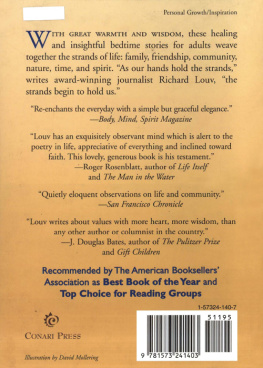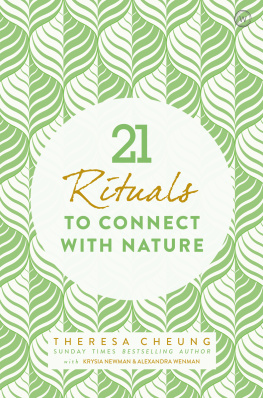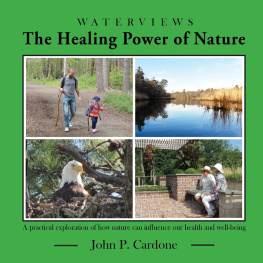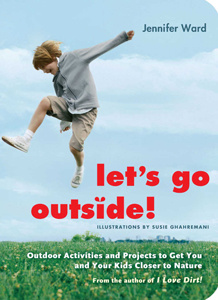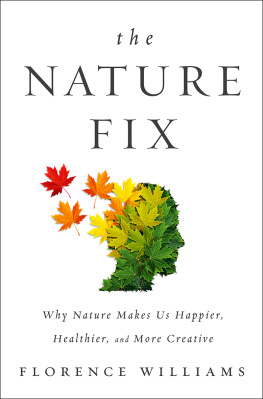THE NATURE PRINCIPLE
ALSO BY RICHARD LOUV
Last Child in the Woods: Saving Our Children
from Nature-Deficit Disorder
Fly-Fishing for Sharks: An American Journey
The Web of Life
FatherLove
101 Things You Can Do for Our Childrens Future
Childhoods Future
America II
THE NATURE
PRINCIPLE
Human Restoration and the End of
Nature-Deficit Disorder

Richard Louv

Published by
Algonquin Books of Chapel Hill
Post Office Box 2225
Chapel Hill, North Carolina 27515-2225
a division of
Workman Publishing
225 Varick Street
New York, New York 10014
2011 by Richard Louv. All rights reserved.
Printed in the United States of America.
Published simultaneously in Canada by Thomas Allen & Son Limited.
Excerpt from The Peace of Wild Things from The Selected
Poems of Wendell Berry, 1998 by Wendell Berry.
Reprinted by permission of Counterpoint.
Library of Congress Cataloging-in-Publication Data
Louv, Richard.
The nature principle : human restoration and the end of nature-deficit
disorder / by Richard Louv.1st ed.
p. cm.
Includes bibliographical references and index.
ISBN 978-1-56512-581-0
1. NaturePsychological aspects. I. Title.
BF353.5N37L69 2011
128dc22 2011003626
Nature-Deficit Disorder is a registered trademark of Richard Louv.
10 9 8 7 6 5 4 3 2 1
First Edition
TO THE MEMORY AND INSPIRATION OF
Thomas Berry and David J. Boe
The search which we make for this
quality, in our own lives, is the central search of any person,
and the crux of any
individual persons story. It is the search
for those moments and situations
when we are most alive.
Christopher Alexander,
The Timeless Way of Building
When despair for the world grows in me
and I wake in the night at the least sound
in fear of what my life and my childrens lives may be,
I go and lie down where the wood drake
rests in his beauty on the water, and the great heron feeds.
I come into the peace of wild things...
I rest in the grace of the world, and am free.
Wendell Berry
CONTENTS
PART ONE
Nature Neurons:
Intelligence, Creativity, and the Hybrid Mind
PART TWO
Vitamin N: Tapping the Power of the Natural World for
Our Physical, Emotional, and Family Fitness
PART THREE
Near Is the New Far: Knowing Who You Are
by Knowing Where You Are
PART FOUR
Creating Everyday Eden: High-Tech/High-Nature
Design Where We Live, Work, and Play
PART FIVE
The High-Performance Human:
Making a Living, a Life, and a Future
ACKNOWLEDGMENTS
FOR THE CONSTRUCTION of this book and the notions it contains, my wife, Kathy, deserves enormous credit, not only for her kindness and help with the writing, but for her intellectual contributions and her artistic mind, which reveals itself often in these pages. Similar gratitude is due my sons. Jason, an urbane writer and editor, helped with much of the early research and contributed his formidable knowledge of philosophy, religion, and advertising; Matthew offered keen insights and wit, often while casting from the middle of a stream. My friend Dean Stahl offered expert editorial support, along with wisdom and humor. Robyn Bjornsson also provided gritty editorial assistance. James Levine is as good a friend as he is an agent. I often say that in Algonquin, I have the best publisher in the world. The brilliant Elisabeth Scharlatt is now giving seminars on patience, or should. Throughout this book, you will find the fingerprints of the supportive Algonquin team, including my persistent and wise editor Amy Gash, Ina Stern, Brunson Hoole, Michael Taeckens, Craig Popelars, Kelly Bowen, and Cheryl Nicchitta. Special thanks to Peter Workman, and to Jackie Green, who handles the universe. Since the publication of Last Child in the Woods, Ive been blessed with a growing family of colleagues who created or now nurture the Children and Nature Network (C&NN), including Cheryl Charles, Amy Pertschuk, Martin LeBlanc, Mike Pertschuk, the late John Parr, Brother Yusuf Burgess, Marti Erickson, Howard Frumkin, Betty Townsend, Fran Mainella; and at the grassroots: Juan Martinez, Avery Cleary, John Thielbahr, Nancy Herron, Mary Roscoe, Bob Peart, Sven Lindblad, and many others who have contributed ideas to this book and encouragement to its author. So have my brother, Mike Louv, and my friends (not all of them listed here, of course), including Karen Landen, Peter and Marti Kaye, Anne Hocker Pearse, John Johns, Neal Peirce, Bob Burroughs, Peter Sebring, Jon Funabiki, Bill Stothers, Cyndi Jones, Jon Wurtmann, Gary Shiebler, John Bowman, Conway Bowman, Steve Bunch, Don Levering, and the extended family called Chapter One. I am also grateful to Bob Perkowitz and ecoAmerica, who helped create Nature Rocks, and to Orion Magazine and the San Diego Union-Tribune, in which I first floated some of these concepts. This book is also, in part, a result of the pioneering work of a growing network of biophilic thinkers, including Stephen Kellert, who invited me to a pivotal conference on biophilic design, attended by E. O. Wilson, David Orr, Tim Beatley, Robert Michael Pyle, and others on the cutting edge of that new world.
THE NATURE PRINCIPLE
INTRODUCTION
Nature-Deficit Disorder for Adults
Listen: theres a hell of a good universe next door; lets go.
E. E. Cummings
WE TRAVELED DOWN a dirt road through the melting adobe village of Puerto de Luna, New Mexico, crossed a low bridge over the shallow Pecos River and entered a valley of green chili fields held by red-rimmed sandstone bluffs. Jason, our older son, then three, was asleep in the backseat.
Is it this turn? I asked my wife.
The next one, Kathy said.
I got out of the rental car and unhooked the gate, and we drove onto the land owned by our friends Nick and Isabel Raven. They were away working in Santa Fe that year, and their farm and house were vacant. We had come to know them before Jason was born. Kathy and I had lived two summers in nearby Santa Rosa, where she had worked in a local hospital.
Now, after a stressful period of our lives, we were back for a couple of weeks. We needed this time for ourselves, and we needed it for Jason.
We entered the dusty adobe house. I inspected the room addition that I had helped Nick build during one of those summers. I turned on the electricity and the water (indoor plumbing had finally come to the Raven homestead), walked into the kitchen, and opened the faucet. A foot-long centipede leapt out of the drain, its tail whipping toward my face. I dont know who was more startled, the centipede or me, but I was the one holding the steak knife.
Later, as Kathy and Jason took naps, I walked outside in the heat, found Nicks rusted folding chair, and set it in the shade of a tree next to the adobe. Nick and I had rested under the branches of this tree between bouts of mixing adobe mud in a pit filled with straw, sand, earth, and water. I thought about Nick, about our political arguments, about the green-chili stew that Isabel heated on a wood stove and served in tin bowls, even in the hottest hours.
Now I sat alone and looked out over the field toward a line of distant cottonwoods that rimmed the Pecos. I watched the afternoon thunderheads rise above the high desert to the east and the layers of sandstone across the river. The field of chili shivered in the sun. Above me, leaves rattled and tree limbs scratched. My eyes settled on a single cottonwood at the river, its branches and upper leaves waving in a slow rhythm above all the others. An hour, perhaps more, went by. Tension crawled up and out of me. It seemed to twist in the air above the green field. Then it was gone. And something better took its place.
Next page

